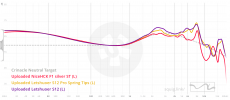This is a review, listening tests, EQ and detailed measurements of the Hidizs MP145. It was sent to me by the company and costs US $150.
View attachment 331068
The immediate impression of the shells is one of jewelry with its machined aluminum case. As you see, the included cable has 4.4mm balanced connection even though it doesn't need that (plenty sensitive to work fine with 3.5 mm unbalanced). Included in the case are three tip variants and nozzles (latter not shown):
View attachment 331069
As is typical, medium size tips match my GRAS 45CA measurement artificial ears best. But for listening, I have to go one size larger. I started with balanced tips but then tried to measure with the other tips. I found the process of swapping tips very difficult. The nozzle is large and the tips barely fit it. Good news is that once you get them on there, they going to stay. With some other IEMs I have had the tip get stuck in my ear while the IEM detaches!

The measured difference with the three tips was very small. Given how hard it was to do this, I did not attempt to change the nozzles so the measurements you see are with the default ones.
The drivers in this IEM are planar magnetic which is a deviation from many others.
Hidizs MP145 IEM Measurement
Fitment on the headphone measurement system was quick and rather painless resulting in this frequency response:
View attachment 331070
As you see, compliance is very good except for some shortfall in treble region. Channel matching was excellent especially given the vagaries of getting IEMs to fit on the test fixture. Relative frequency response gives a chance for minor tweaking:
View attachment 331071
Distortion is exceedingly low:
View attachment 331072
It is basically non-existent at 94 dBSPL and hardly gets worse at higher levels. Here it is in absolute level:
View attachment 331073
Group delay is very clean but this is typical of many IEMs:
View attachment 331074
Being planar magnetic, impedance is flat and low:
View attachment 331075
Sensitivity is a bit low for an IEM but not the worst we have measured:
View attachment 331076
You should have no trouble driving it with many sources. Normal listening level on my RME ADI-2 Pro is around -45 dB.
Hidizs MP145 IEM Listening Test and Equalization
Initial impression was one of neutral present for the most part, lacking a bit of emphasis in highs. I could certainly live with this but why not apply some EQ to brighten things up:
View attachment 331077
I first created the right two filters. That gave the treble region more light but then the overall signature was too bright (even after I turned them down some). So I put in the shelving filter to bring up the deep bass. That nicely balanced things. To get rid of a tiny bit of bass bloat, I added the pink filter (2). Once there, the sound while not super different, was a lot more exciting for the lack of a better word. Sub-bass was impressive in its reproduction and how clean it was. Highs would sparkle and sometimes startle (for an IEM) the way they externalized. I sat there listening to track after track and could not stop. Eventually I did and took the pictures for the review, only to go back wearing them as I type this! The fidelity with this bit of EQ is just stunning.
Conclusions
The MP145 is a nicely made, good looking IME which comes very close to approximating our target (with its other nozzles, it may be closer). That makes it more than usable as is. A bit of EQ though, adds more flavor to the sound making it reference quality as far as I am concerned, putting a smile on my face on track after track. Yes, I have tested cheaper IEMs with similar experience but here you have another option made differently with some tuning at your disposal.
I am going to recommend the Hidizs MP145 IEM especially when used with a bit of EQ.
------------
As always, questions, comments, recommendations, etc. are welcome.
Any
donations are much appreciated using
: https://www.audiosciencereview.com/forum/index.php?threads/how-to-support-audio-science-review.8150/


